- Home
- David R. George III
Allegiance in Exile Page 2
Allegiance in Exile Read online
Page 2
Kirk stopped for a moment to take in the scene and observe his frontline command crew, all of them already at their positions. The captain normally arrived on the bridge before any of them, comfortably ahead of the start of alpha shift. Upon waking in his quarters that day, though, he’d tarried through his dawn routine, slowed by a heavy wistfulness.
But I didn’t feel that way just this morning, Kirk thought. Really, his pensive state of mind had arisen the night before. As he recorded the final log entry for the day, he realized that the stardate marked the end of his fourth year aboard Enterprise. That time as a starship captain had proven not only the most satisfying of his professional life, but also the most fulfilling from a personal standpoint. It unnerved him to consider that he’d already put eighty percent of Enterprise’s five-year mission behind him.
Moving to his right, toward an opening in the railing that rimmed the lower, central portion of the bridge, Kirk passed Uhura where she crewed the communications console. The lieutenant had served as a member of the ship’s senior staff for virtually the entire voyage, and although there had been some flux in personnel assignments and the command structure near the beginning of the mission, a similar constancy had held true since that time for most of his officers: Spock doing double duty as exec and the head of Enterprise’s science division, Scotty as chief engineer, Sulu at the helm, McCoy down in sickbay as chief medical officer. Even young Chekov had to that point manned navigation for three years.
As Kirk padded down from the outer ring of the bridge to its inner section, he shifted from reflecting on the reliability and longevity of his command crew to the interpersonal relationships that had grown among them. He felt closer to the members of his senior staff than he had to any other group of people he’d ever known; in important ways, they had become like a family to him. It gave him pause to wonder where they all would be a year and a day from that moment.
In the center of the bridge, the captain circled around to the front of the vacant command chair. He knew that another of his officers, Bill Hadley, had drawn the watch as gamma-shift duty officer that month, but even though Spock presently worked at the primary science station, the first officer had clearly relieved the lieutenant. Kirk settled into the empty seat.
Seeking to free himself from his melancholy, the captain turned his attention to the main viewscreen. Over the course of the previous several days, an empty starscape had prevailed as Enterprise carried her crew to their next assignment. As Kirk expected, though, the limitless depths of space through which the ship traveled had been replaced by the shallow arc of a planet cutting across the bottom half of the display.
Kirk studied the image on the screen. He saw a topography painted in the hues he normally associated with life-sustaining worlds. Browns and ochers mixed with swatches of deep green to describe a set of continents and outlying archipelagos, vast stretches of aquamarine defined oceans, and great sweeps of white clouds hovered above it all.
The captain glanced to the right, up to where his first officer operated the main science console on the starboard periphery of the bridge. The commander stood bent over the hooded viewer that provided concentrated visual access to sensor readings and other information. “Mister Spock, report.”
Spock straightened and turned his lanky frame toward Kirk. “As scheduled, Captain, the Enterprise arrived at zero-one-twenty hours at the planetary system designated R-Seven-Seven-Five. The crew has performed basic scans of its three jovian worlds and has dispatched probes into their atmospheres, as well as to seven of their moons; we are continuing to receive telemetry from each of them. We are presently in orbit of the lone terrestrial planet and conducting a detailed survey of it.”
Kirk peered back at the viewscreen. “Just one rocky planet?” he asked. “Isn’t that unusual?”
“It is true that fewer than three percent of all known systems possess only a single terrestrial world,” Spock explained, “but such an occurrence is otherwise of little note.” The first officer walked along the railing until he reached the opening beside Uhura, then descended to the center of the bridge to stand beside the command chair. “The number of terrestrial planets that develop about a star is a function of the amount of dust in the nascent solar nebula, as well as of the random collision and accrual of those particles into larger and larger bodies. The cloud of gas and granular matter surrounding R-Seven-Seven-Five after its formation likely contained fewer solid grains than in systems with multiple rocky worlds. It is worth observing, however, that an asteroid belt orbits next to the star, and that another, larger belt does so between the first and second planets, placing the aggregate mass of the system on the low end of, but well within, the normal range.”
Kirk looked back at Spock. “What else do we know about R-Seven-Seven-Five?” The captain had read Starfleet’s exceedingly brief précis about the system several days earlier, but he liked to hear his first officer’s description of such details.
“Prior to our arrival here, we knew very little,” Spock said. “It was charted one hundred twenty-three years ago by the crew of a Vulcan starship, the R’Tor. They did not explore the system.”
During the course of Kirk’s career in Starfleet, he had frequently heard and read the phrase Charted but not explored employed in reference to astronomical objects identified by agents of the erstwhile Vulcan High Command; it never ceased to confound him. Although the former governmental body had been tasked with the military defense of the Vulcan people, it had also overseen civilian operations, including scientific research and the deployment of their interstellar fleet. Kirk’s own interactions with Spock and others of his people revealed among them a uniformly robust curiosity about the universe. Even though Spock’s father had disapproved of his son enlisting in Starfleet, he’d wanted him to join the Vulcan Science Academy. Given all of that, the notion that the crew of R’Tor, or those of its sister ships, would map an unfamiliar star system without then exploring that system felt counterintuitive to everything Jim Kirk thought he knew about Vulcans. He did recall from his history studies that their society had undergone considerable turmoil a century or so earlier, at which time they had disbanded the High Command, but such a fundamental shift—not just in their priorities, but in their communal mind-set—still seemed improbable to Kirk.
And yet here we are, the captain told himself. In another solar system that the Vulcans looked at in passing, made note of, and then ignored.
“Are there any signs of life?” Kirk asked, hopeful. Of all his crew’s many accomplishments, he most valued their discoveries of intelligent species previously unknown to the Federation. He in particular appreciated the opportunity to make first contact with spacefaring civilizations, though he understood that no such prospect would arise at R-775; had the crew detected any ships in or about the system, they would have notified the captain at once, even during his off-duty hours.
“The planet is Class-M,” Spock said, indicating its suitability for humanoid life. “It supports a myriad of complex flora and fauna across its surface and within its seas, but detailed scans have uncovered no evidence of hominids or other advanced species.”
Kirk’s lips drew into a thin line as he peered back at the viewscreen, at the image of the fertile planet displayed there. He looked at the segment of the visible surface that fell outside the reach of the planet’s star, and noted that darkness reigned there unbroken by artificial lighting. He felt more deeply disappointed than usual, doubtless because of his realization that the final year of Enterprise’s mission lay immediately before him.
Maybe Starfleet Command will keep me aboard the ship, he thought, searching for any optimism he could find. He might have to replace some members of his senior crew as they progressed in their own careers, but at least he would still have Enterprise. Or the admirals might transfer me to another ship, Kirk supposed. Even in that case, though, at least he would retain his captaincy.
Both possibilities seemed reasonable, he tried to tell himself, and
perhaps they even seemed likely. But Kirk knew that while he had champions at Starfleet Headquarters in San Francisco, he also had detractors. His tenure aboard Enterprise had been marked by a number of significant triumphs—including numerous successful first contacts—but had also been marred by some notable disappointments.
Unable to escape the morass of introspection, he remembered well his inability to keep alive the intelligent creature the crew had encountered on planet M-113—the last being of its kind, and whose death marked the extinction of its species. He had likewise failed to prevent the demise of Kodos, the former governor of the Tarsus IV colony, who had ruthlessly murdered half its population and whom Kirk had wanted to bring to justice. He also recalled with terrible shame arguing with the Organians that the Federation and the Klingon Empire should be permitted to engage in a shooting war—a war that surely would have killed millions, if not billions, of people, destroying life on a planetary scale.
So many mistakes, Kirk thought.
One of those that retained a primacy among his recollections had occurred two and a half years earlier. He had introduced primitive firearms to the hill people of the planet Neural, in what he had come to recognize as a misguided attempt to restore the balance of power between them and the villagers, who’d been supplied weapons by the Klingons. Although Starfleet Command continued to support that arms race, the issue had caused a tremendous amount of heated debate among the admirals. For his part, Kirk regretted implementing his solution, which he had come to regard as a miscalculation not only horrible in its consequences, but immoral in its very conception. He still often reflected on the situation, even going so far as to submit alternate proposals to Command, including the relocation of the hill people to another world.
I wonder if Tyree’s still alive.
How many times had he speculated about that? Years before returning to Neural as the captain of Enterprise, Kirk had visited the planet as a young officer fresh out of Starfleet Academy. He masqueraded as a native and embedded himself in their culture. The beauty of the place captivated him, as did the tranquil, peaceful life enjoyed by its inhabitants. Tyree, a member of the hill people back then, and later their leader, had befriended him.
And I betrayed his fellowship by providing his tribe—by providing him—with the concept of vengeance, along with the weapons to carry it out.
Kirk suddenly realized that an uncomfortable silence surrounded him, that he had become mired in his dour thoughts and dark memories. Willing himself back into the moment, he turned to his first officer. “Very well, Mister Spock,” he said, not even recalling the last words the commander had spoken to him—if he’d even heard them at all. “How long do you estimate a full analysis of the planet will take?”
“We have thus far mapped all land masses in detail,” Spock said. “We are presently engaging in detailed sensor sweeps of the geology, the hydrosphere, and the climate, as well as cataloguing the abundance of plant and animal life. Given the size of the planet and the diversity of its ecosystem, a complete survey will require—”
“Mister Spock,” interrupted a male voice. Kirk looked past the Vulcan toward one of the bridge’s secondary stations, the one adjoining Spock’s own console. There, a young officer clad in the azure uniform shirt of Starfleet’s science division turned from his panel and peered toward the captain and first officer. Kirk recognized the ensign as Daniel Davis, a human assigned to Enterprise less than a year earlier. “I’m reading refined metal on the planet’s surface.”
Kirk glanced up at Spock. Though the Vulcan’s expression remained neutral, the captain could read the interest in his eyes. During their time together aboard Enterprise, the two had become the best of friends, and despite the stoicism with which his first officer conducted himself, Kirk had come to know him quite well.
“Specify,” Spock said, addressing the ensign. “What types of refined metal, and in what quantities?” Kirk understood that Spock would resist venturing an opinion about what the presence of such materials on the planet might indicate, but with the lack of intelligent life, the captain suspected they had run across a spacecraft that had set down there.
“I’m reading steel . . . aluminum . . . even some smaller amounts of tritanium and rodinium,” Davis said, looking back at his console and reading from a display. The list seemed to bolster Kirk’s theory that they had discovered a space vessel of some kind; Starfleet commonly utilized tritanium and rodinium in the construction of its own starship hulls. When the ensign peered back up from his station, he said, “There’s enough down there to suggest a city.”
Both of Kirk’s eyebrows rose in surprise, while one of Spock’s did the same. The first officer strode to a break in the railing on the starboard side of the bridge and mounted the outer deck. Kirk waited in the command chair as Ensign Davis turned back to his console and Spock leaned in over him. The two spoke quietly for a moment as Davis worked his controls. Finally, the first officer stood up and turned toward Kirk.
“Sensors detect not just refined metals, Captain,” Spock said, “but also concrete and processed woods.”
“Those do sound like urban building materials,” Kirk noted.
“Indeed,” Spock agreed. “And they appear to be laid out in a grid-like pattern, supporting Ensign Davis’s contention that they define a city. But the materials also appear to be in at least partial disarray, and scans show no habitation in the area, other than by local wildlife.”
“How do you account for all that?” Kirk asked.
“If it actually is a city, it seems that its builders have departed,” Spock said. “It is unclear whether the deterioration was the cause or the result of that abandonment.”
Kirk’s mind raced with possibilities. He rose from the command chair and paced over to the railing, where he peered up at Spock. “What about radiation levels?”
Spock looked back at Ensign Davis, who once more operated his panel. “I’m reading nothing out of the ordinary,” Davis reported.
“So we’re probably not talking about an attack,” Kirk concluded.
“At least not one conducted recently,” Spock agreed, “or carried out with energy weapons.”
Kirk nodded. Though Enterprise traveled in unexplored space far from the Klingon and Romulan empires, and away from other known belligerents, the captain knew that the Federation did not reach out beyond its borders alone. While he puzzled over the existence of a single, apparently abandoned city down on the planet, knowing that he and his crew would not be entering a battleground would make his next decision easier.
After first contact, after observing intelligent but pre-warp cultures, Kirk counted the discovery of information about lost peoples among his crew’s more satisfying endeavors. Such an opportunity had clearly just arisen. “Mister Spock, outfit a landing party. You’ll join me, along with Doctor McCoy and our new A-and-A officer.” The captain looked toward Ensign Davis. “I want you to scan the city in detail and be prepared to collate your findings with those of the landing party.”
“Yes, Captain,” Davis said.
That quickly, the captain’s morning had improved. The despondence with which he had awoken gave way to anticipation about visiting the surface of an unexplored world and seeing firsthand the mysterious environs of a deserted alien city. In just moments, he knew, he would enter the transporter room, preparing to face something that he dreaded in his private life, but that exhilarated him in his role as Enterprise captain: the unknown.
Two
Ensign Mai Duyen Trinh reached the transporter room almost at a gallop, her stomach aflutter. In one hand, she carried her field jacket, and in the other, a tricorder expressly configured for her specialties, the device’s memory packed with a cornucopia of comparative and historical data. She felt foolish rushing through the corridors, but she had no desire to arrive late for her first assignment to a landing party.
Fifteen minutes earlier, Trinh had stood in one of Enterprise’s large recreation rooms, collaboratin
g with three of her colleagues. Jacqueline Trieste and Jeurys Mejia served the ship as anthropologists, while Veldaclien ch’Gorin worked as an archaeologist. They’d reserved the space in advance, arriving early in the morning to use it when it would least inconvenience their crewmates. The quartet utilized the rec room’s holographic equipment to re-create as best they could a site that the crew had visited three months prior, before Trinh’s posting to Enterprise.
Although Trinh hadn’t taken part in that earlier mission to the previously unexplored world of Drissana II, she had subsequently joined the ship as its so-called A-and-A officer—archaeology and anthropology—and so headed up both departments. Direct observations and sensor scans performed on the planet provided a great deal of information about the most advanced species found there, a type of humanoid roughly equivalent to Neanderthal man on Earth. The ongoing analysis of the data, though, raised some puzzling questions. After several frustrating weeks fruitlessly searching for answers, Trinh suggested employing the rec room’s holographic capabilities to examine those issues more closely and to test any hypotheses the team might develop. With recent progress in imaging technology, such methods had grown in their effectiveness as scientific tools.
With the help of Nora Hardy, one of the ship’s computer specialists, Trinh and the others had loaded into the control matrix of the recreation room a plethora of sensor readings taken on Drissana II. The resulting projection reproduced one of the hunting grounds of the native people. Tall grass swayed across a stretch of gently rolling hills, the slender stalks pushed in waves by a delicate breeze. Trinh took up a position beside her colleagues on the edge of the veld, anxious for the programmed scene to unfold.
As she waited, Trinh raised her right hand and studied the artifact clasped in her fingers. A reproduction of a stone object found in large numbers among the inhabitants of Drissana II, the rough-hewn tool resembled, more than anything else, a rudimentary blade. It measured nearly as long as Trinh’s forearm, with most of its extent tapering to a point at one end. The scientists’ confusion arose from the other end of the object, which narrowed at a shallower angle to a second tip. It looked like one short and one tall triangle, both coarsely fashioned out of rock, and fixed together at their bases.

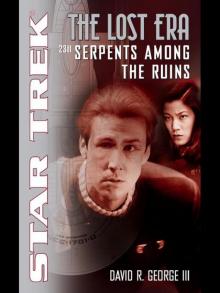 Serpents Among the Ruins
Serpents Among the Ruins The Fire and the Rose
The Fire and the Rose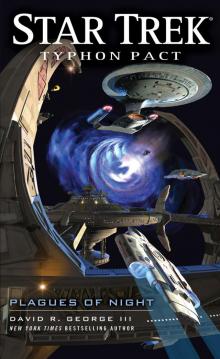 Star Trek: Typhon Pact 06: Plagues of Night
Star Trek: Typhon Pact 06: Plagues of Night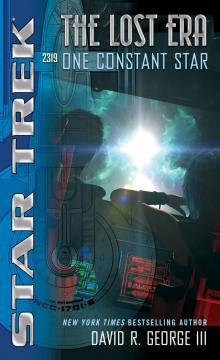 Star Trek: The Lost Era - 08 - 2319 - One Constant Star
Star Trek: The Lost Era - 08 - 2319 - One Constant Star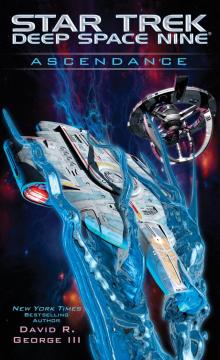 Star Trek: Deep Space Nine: Ascendance
Star Trek: Deep Space Nine: Ascendance Star Trek: TOS: Allegiance in Exile
Star Trek: TOS: Allegiance in Exile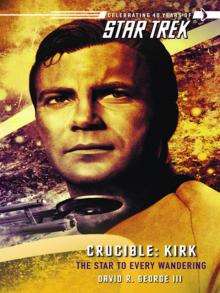 Crucible: Kirk
Crucible: Kirk Crucible: McCoy
Crucible: McCoy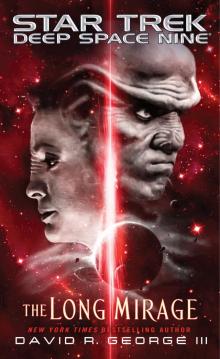 The Long Mirage
The Long Mirage Original Sin
Original Sin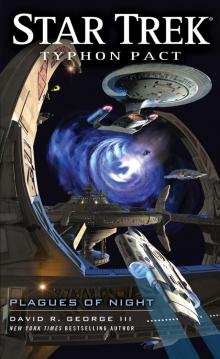 Star Trek: Typhon Pact: Plagues of Night
Star Trek: Typhon Pact: Plagues of Night Allegiance in Exile
Allegiance in Exile Sacraments of Fire
Sacraments of Fire Star Trek: Typhon Pact: Rough Beasts of Empire
Star Trek: Typhon Pact: Rough Beasts of Empire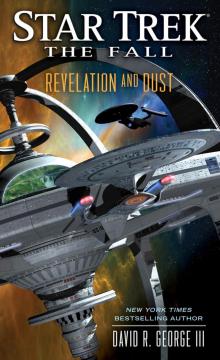 Star Trek: The Fall: Revelation and Dust
Star Trek: The Fall: Revelation and Dust